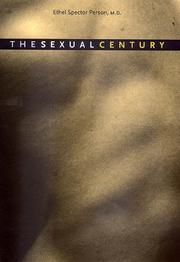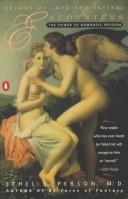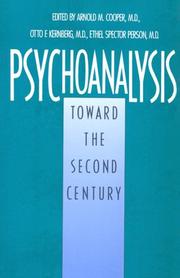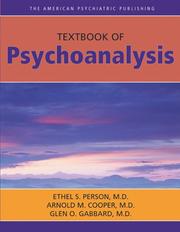| Listing 1 - 10 of 14 | << page >> |
Sort by
|

ISBN: 0300147279 058536429X 9780585364292 9780300147278 0300076045 9780300076042 0300076045 Year: 1999 Publisher: New Haven [Conn.] Yale University Press
Abstract | Keywords | Export | Availability | Bookmark
 Loading...
Loading...Choose an application
- Reference Manager
- EndNote
- RefWorks (Direct export to RefWorks)
Over the course of the past century, sexual liberation has transformed the way in which most of us regard our bodies and live our sexual lives. Now a preeminent psychoanalytic theoretician on sex and gender discusses what has gone into this unquiet revolution-the roles played by sexologists and psychoanalysts, antibiotics and birth control, the liberation movements, and Freud's insight that sex has as much to do with the mind as with the genitals.In this collection of new and previously published papers, Ethel Person writes of the centrality of sexuality to our identity. She describes the role of fantasy in desire, its different expression in the sexes, and the way in which desire is inevitably intertwined with power. Her classic papers on transvestism, transsexualism, and cross-dressing homosexuals, written with Lionel Ovesey, help us to understand how gender and sex develop in all of us. The public acceptance of the transsexual, says Person, is emblematic of the profound scientific and intellectual shifts that have taken place in the past hundred years. The way that sex and gender develop and are experienced and expressed is the resultnot only of nature and nurture but also of the cultural zeitgeist, its unspoken values and biases.
Gender identity. --- Sex differences (Psychology) --- Sex discrimination against women. --- Sex role --- Sex role. --- Gender Identity. --- Prejudice --- Women. --- Anti-Semitism --- Implicit Bias --- Islamophobia --- Anti Semitism --- Anti-Semitisms --- Bia, Implicit --- Bias, Implicit --- Islamophobias --- Prejudices --- Gender role --- Sex (Psychology) --- Social role --- Gender expression --- Sexism --- Discrimination against women --- Subordination of women --- Women, Discrimination against --- Feminism --- Sex discrimination --- Women's rights --- Male domination (Social structure) --- Sex identity (Gender identity) --- Sexual identity (Gender identity) --- Identity (Psychology) --- Queer theory --- Girls --- Woman --- Women's Groups --- Girl --- Women Groups --- Women's Group --- Gender --- Gender Identities --- Identity, Gender --- Transgender Persons --- Psychological aspects. --- Sex differences (Psychology). --- Psychoanalyse --- Psychoanalytische theorie. --- Gender roles --- Gendered role --- Gendered roles --- Role, Gender --- Role, Gendered --- Role, Sex --- Roles, Gender --- Roles, Gendered --- Roles, Sex --- Sex roles --- Gender dysphoria --- Prejudice.

ISBN: 0393025276 Year: 1988 Publisher: London Norton
Abstract | Keywords | Export | Availability | Bookmark
 Loading...
Loading...Choose an application
- Reference Manager
- EndNote
- RefWorks (Direct export to RefWorks)
Book
ISBN: 2227137495 9782227137493 Year: 1998 Publisher: Paris: Bayard,
Abstract | Keywords | Export | Availability | Bookmark
 Loading...
Loading...Choose an application
- Reference Manager
- EndNote
- RefWorks (Direct export to RefWorks)
Book
ISBN: 0029114306 Year: 1988 Publisher: London Collier Macmillan
Abstract | Keywords | Export | Availability | Bookmark
 Loading...
Loading...Choose an application
- Reference Manager
- EndNote
- RefWorks (Direct export to RefWorks)
Book
ISBN: 0429475047 1280125640 9786613529503 1849409587 9781849409582 9781280125645 9781780499901 1780499906 9781780491080 1780491085 9781780491080 9780429896963 0429914040 Year: 2012 Publisher: London Karnac Books
Abstract | Keywords | Export | Availability | Bookmark
 Loading...
Loading...Choose an application
- Reference Manager
- EndNote
- RefWorks (Direct export to RefWorks)
On Narcissism: An Introduction is a densely packed essay dealing with ideas that are still being debated today - from the role of narcissism in normal and pathological development and the relationship of narcissism to homosexuality, libido, romantic love, and self-esteem to issues of therapeutic intervention. The contributors place the work in the context of Freud's evolving thinking, point out its innovations, review its problematic aspects, and examine how its theoretical concepts have been elaborated more recently by analysts of diverse theoretic persuasions. In addition, they use Freud's text to chart new developments in psychoanalysis and point toward still unresolved problems. An introduction by Joseph Sandler, Ethel Spector Person, and Peter Fonagy provides a succinct overview of the material.Contributors: Willy Baranger, David Bell, R. Horacio Etchegoyen, Peter Fonagy, Leon Grinberg, Bela Grunberger, Heinz Henseler, Otto F. Kernberg, Paul H. Ornstein, Ethel Spector Person, Joseph Sandler, Hanna Segal, Nikolaus Treurniet, Clifford Yorke.
Narcissism. --- Ego erotism --- Erotism, Ego --- Narcism --- Egoism --- Psychology, Pathological --- Freud, Sigmund, --- Freud, Sigmund

ISBN: 0300045581 Year: 1989 Publisher: New Haven London Yale University Press
Abstract | Keywords | Export | Availability | Bookmark
 Loading...
Loading...Choose an application
- Reference Manager
- EndNote
- RefWorks (Direct export to RefWorks)
Psychanalyse --- Psychoanalyse --- Psychoanalysis --- Psychoanalysis. --- Psychoanalytic Theory. --- -Psychology --- Psychology, Pathological --- Psychoanalytical Theory --- Theory, Psychoanalytic --- Oral Character --- Character, Oral --- Characters, Oral --- Oral Characters --- Psychoanalytic Theories --- Psychoanalytical Theories --- Theories, Psychoanalytic --- Theories, Psychoanalytical --- Theory, Psychoanalytical --- Psychodynamic Analysis --- Analyses, Psychodynamic --- Analysis, Psychodynamic --- Psychodynamic Analyses --- trends. --- History --- -Psychoanalysis. --- -trends. --- -Psychanalyse --- -Psychoanalysis --- Psychoanalytic Theory --- Psychology --- trends --- 20th century --- Psychoanalysis - History - 20th century.
Book
ISBN: 0300047932 9780300047936 Year: 1990 Volume: vol 1 Publisher: New Haven (Conn.): Yale university
Abstract | Keywords | Export | Availability | Bookmark
 Loading...
Loading...Choose an application
- Reference Manager
- EndNote
- RefWorks (Direct export to RefWorks)

ISBN: 1585621528 9781585621521 Year: 2005 Publisher: Washington, DC : American Psychiatric Publishing
Abstract | Keywords | Export | Availability | Bookmark
 Loading...
Loading...Choose an application
- Reference Manager
- EndNote
- RefWorks (Direct export to RefWorks)
The comprehensive The American Psychiatric Publishing Textbook of Psychoanalysis is the only textbook of its kind in this distinguished field. Both a clinical guide and a reference book, this essential text focuses not only on psychoanalytic theory and treatment but also on developmental issues, research, and the many ways in which theoretical psychoanalysis intersects with contiguous disciplines. The editors, recognized experts in the field, have brought together a remarkable 39 distinguished contributors whose broad-based interests make this textbook a unique reference for interdisciplinary psychoanalysis. The textbook is organized into 6 parts: -Part I: Core ConceptsAIntroduces basic concepts, such as motivation, the dynamic unconscious, the importance of early relationships, internalization, object relations theory, intersubjectivity, and sex/gender. -Part II: Developmental TheoryAAddresses the developmental orientation in contemporary psychoanalysis, developmental theories and their relationship with other disciplines, attachment theory/research, and the psychoanalytic understanding of mental disorders. -Part III: Treatment and TechniqueADefines what a psychoanalyst is and how he or she is trained; and presents virtually every treatment and technique, from transference/countertransference, treatment theories and their technical consequences, and interpretation, resistance, and process to termination/re-analysis, psychopharmacology, child analysis, and ethics. -Part IV: ResearchADescribes the burgeoning research in psychoanalysis, focusing on outcome, process, developmental, and conceptual research. -Part V: History of PsychoanalysisATraces the history of psychoanalysis, showing how individual personality, world events, and cultural differences have led to varieties of discoveries and perspectives. -Part VI: Psychoanalysis and Related DisciplinesADetails the relevance of interdisciplinary sources to Freud's ideas and the influences of psychology, anthropology, philosophy, literature, the arts, politics, international relations, and neuroscience. Written with a minimum of professional jargon, this in-depth work also includes an extensive glossary and name and subject indexes. No other psychoanalysis textbook is as comprehensive in scope with such a broad array of contributors as The American Psychiatric Publishing Textbook of Psychoanalysis. This up-to-date reference will find a wide audience not only among psychoanalysts, psychiatrists, educators, and students but also among professionals in allied disciplines such as psychology, anthropology, literature, the arts, philosophy, politics, and neuroscience. The editors and contributors to this remarkable compendium demonstrate that psychoanalytic approachesAat times in combination with psychopharmacological therapyAcontinue to play a vital role in the treatment of specific psychiatric disorders.
Psychoanalysis. --- Psychoanalytic Theory. --- Psychoanalytic Therapy. --- Psychoanalysis --- Psychanalyse --- Psychology --- Psychology, Pathological --- Psychoanalytic Theory --- Psychoanalytic Therapy
Book
ISBN: 9781855757448 Year: 2009 Publisher: London : Karnac,
Abstract | Keywords | Export | Availability | Bookmark
 Loading...
Loading...Choose an application
- Reference Manager
- EndNote
- RefWorks (Direct export to RefWorks)
Contributors: Carlos Mario Aslan, Martin Bergmann, Roosevelt M.S. Cassorla, Florence Guignard, María Cristina Melgar, Thomas H. Ogden, María Lucila Pelento, Jean-Michel Quinodoz, Priscilla Roth, Vamik D. Volkan, with a foreword by Ethel Spector Person. 'I am confident that the re-birth of the series will prove to be an extremely creative one. It is a good omen that the new edition starts with an introduction by Martin Bergmann, one of the most renowned psychoanalysts in the United States, and that the series begins with Mourning and Melancholia. Both melancholia and mourning are triggered by the same thing, that is, by loss. The distinction often made is that mourning occurs after the death of a loved one while in melancholia the object of love does not qualify as irretrievably lost. Melancholia is about a loss that is sometimes retrievable. What the IPA lost for a long stretch of time was the Freud series. Thus, the title seems a fitting introduction to the rebirth of this series. It is an antidote to the mourning and melancholia that some of us may have felt in losing the continuity of the series. This vital resurrection bodes well for the ongoing interchange among all our regions, each with its specific, andsometimes, unique, contributions.' - From the foreword by Ethel Spector Person.
Book
ISBN: 1782411712 9781782411710 1299673953 9781299673953 9781781813034 1781813035 0429916779 Year: 2013 Publisher: London Karnac Books
Abstract | Keywords | Export | Availability | Bookmark
 Loading...
Loading...Choose an application
- Reference Manager
- EndNote
- RefWorks (Direct export to RefWorks)
Masochism. --- Sadomasochism. --- Algolagnia --- Algophilia --- BDSM (Sexual behavior) --- Masochism, Sexual --- S & M (Sadomasochism) --- S and M (Sadomasochism) --- S/M (Sadomasochism) --- Sadism, Sexual --- Sado-masochism --- Sexual masochism --- Sexual sadism --- Psychosexual disorders --- Leather lifestyle --- Masochism --- Sadism --- Sexual dominance and submission --- Psychic masochism --- Paraphilias --- Personality disorders --- Sadomasochism --- Suffering --- Freud, Sigmund, --- Freud, Sigmund
| Listing 1 - 10 of 14 | << page >> |
Sort by
|

 Search
Search Feedback
Feedback About UniCat
About UniCat  Help
Help News
News